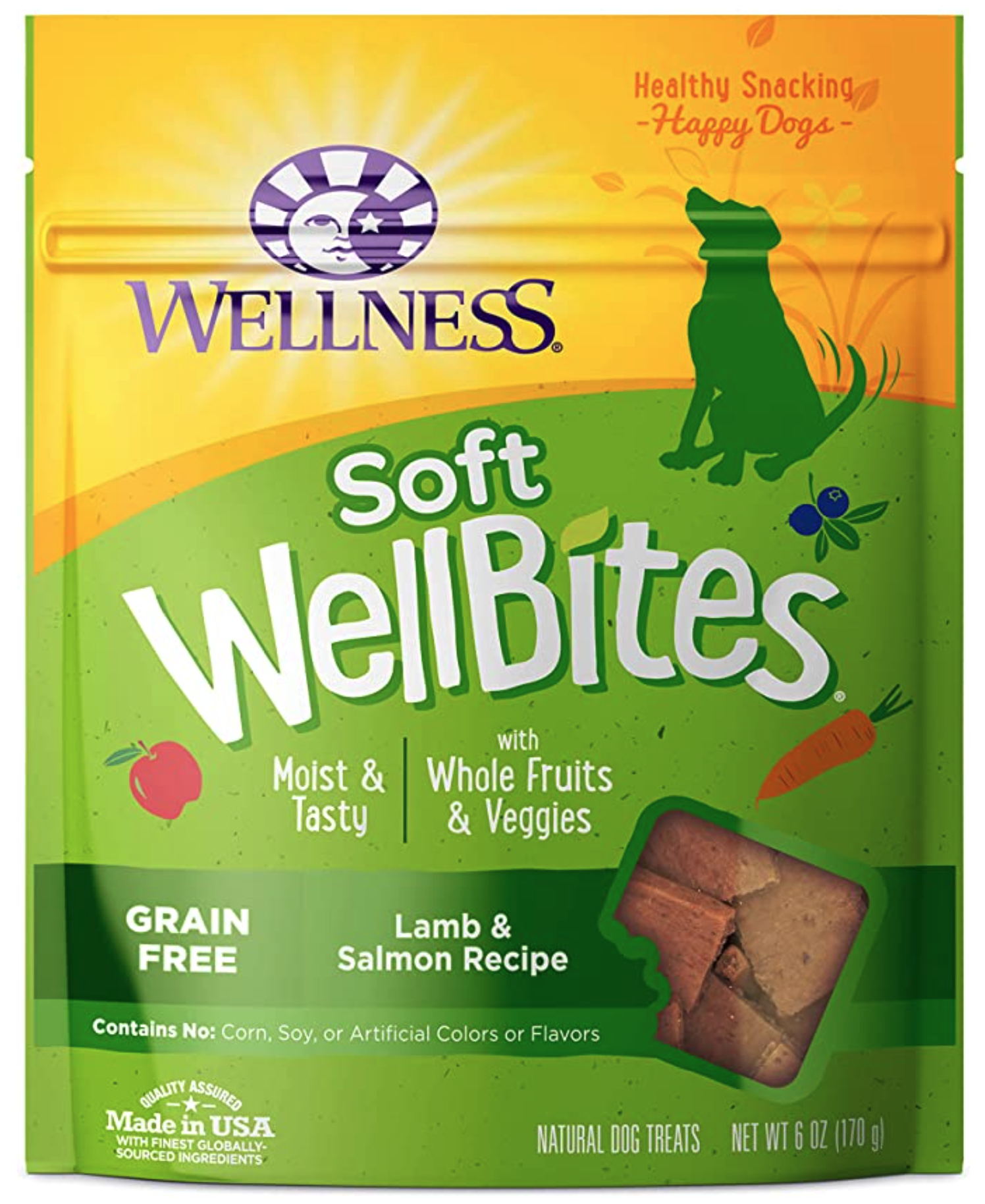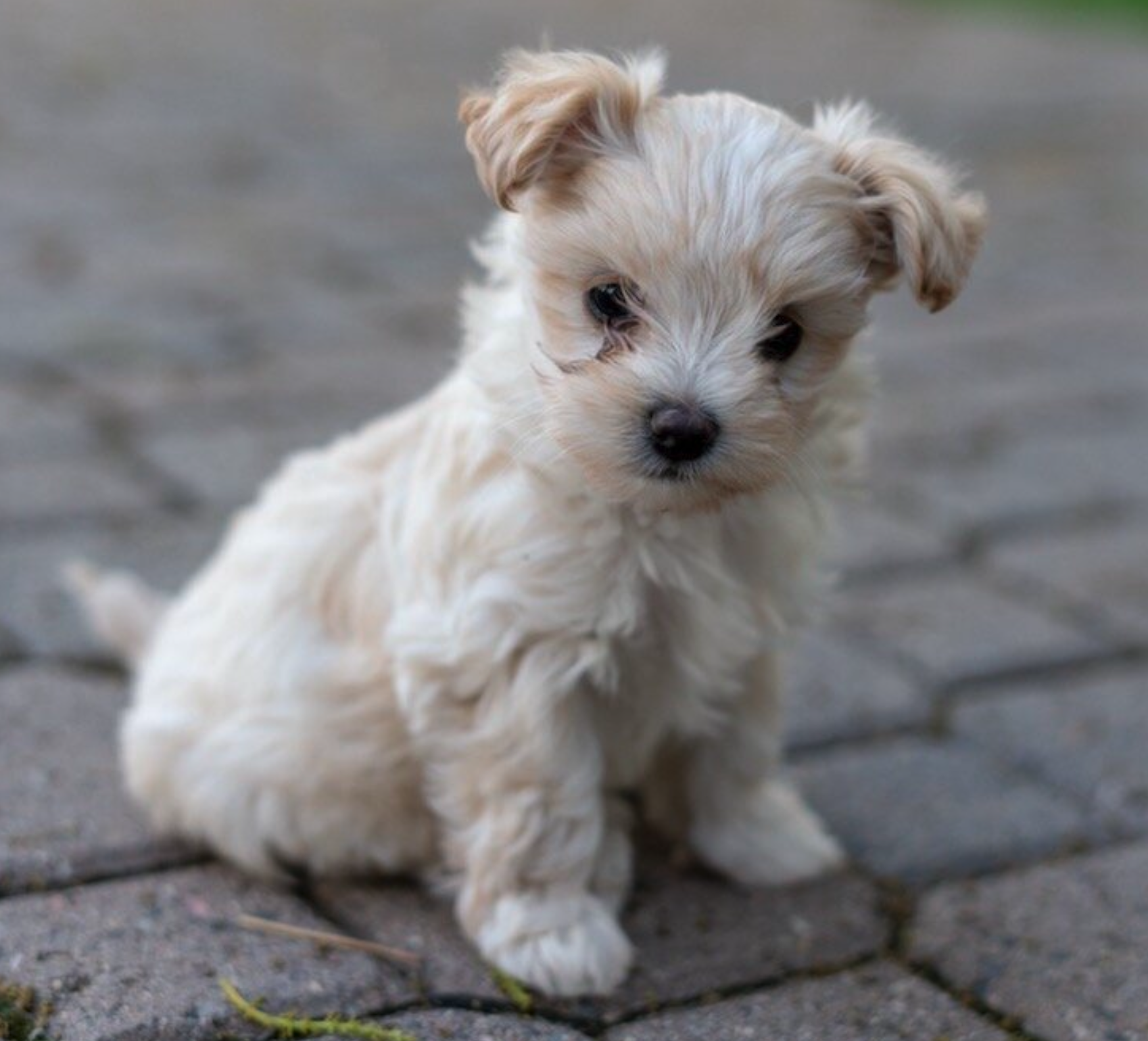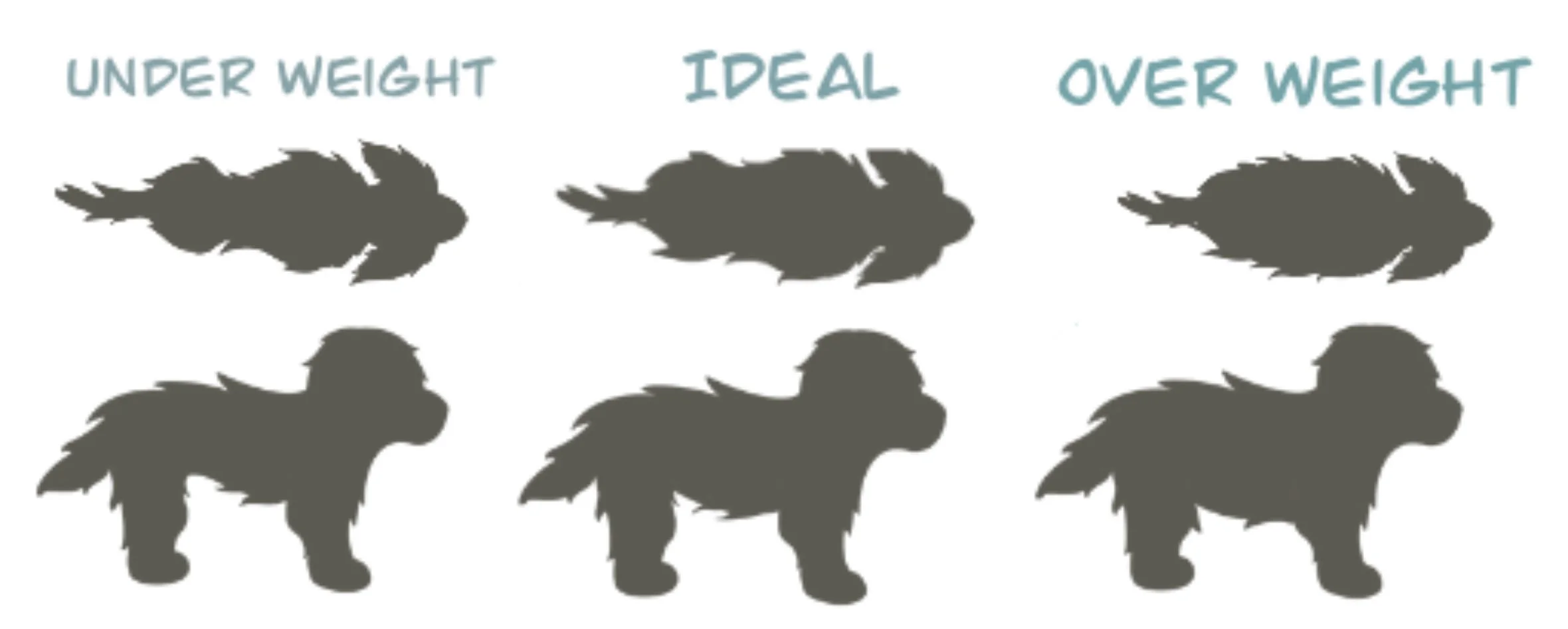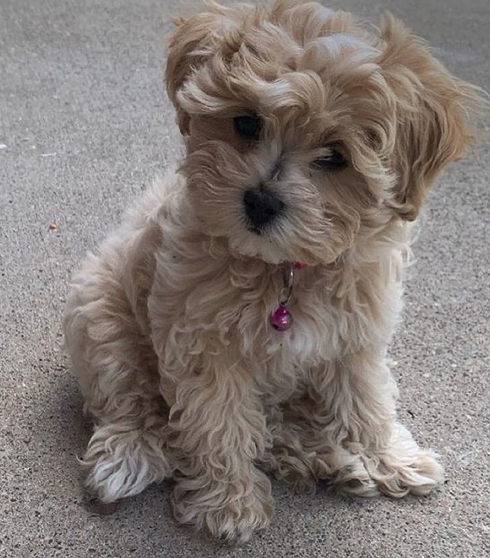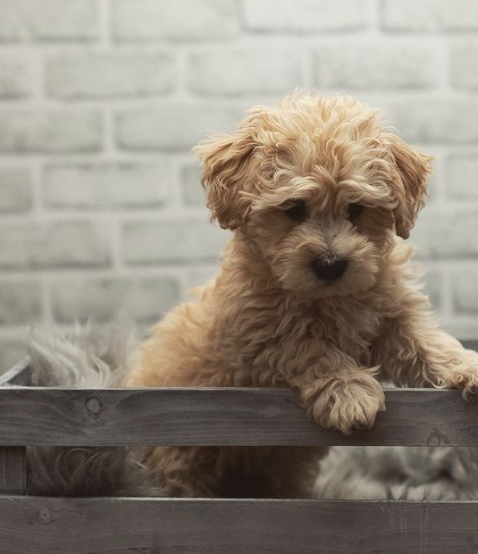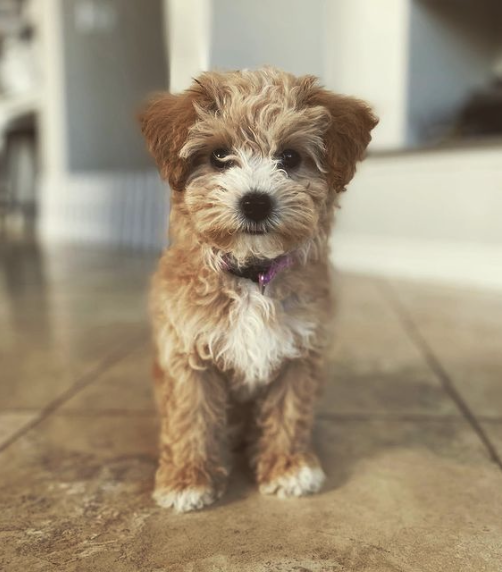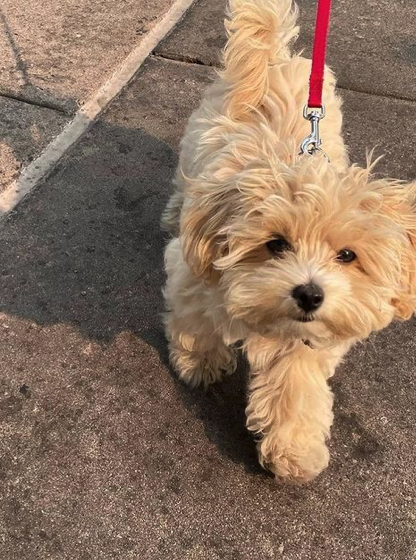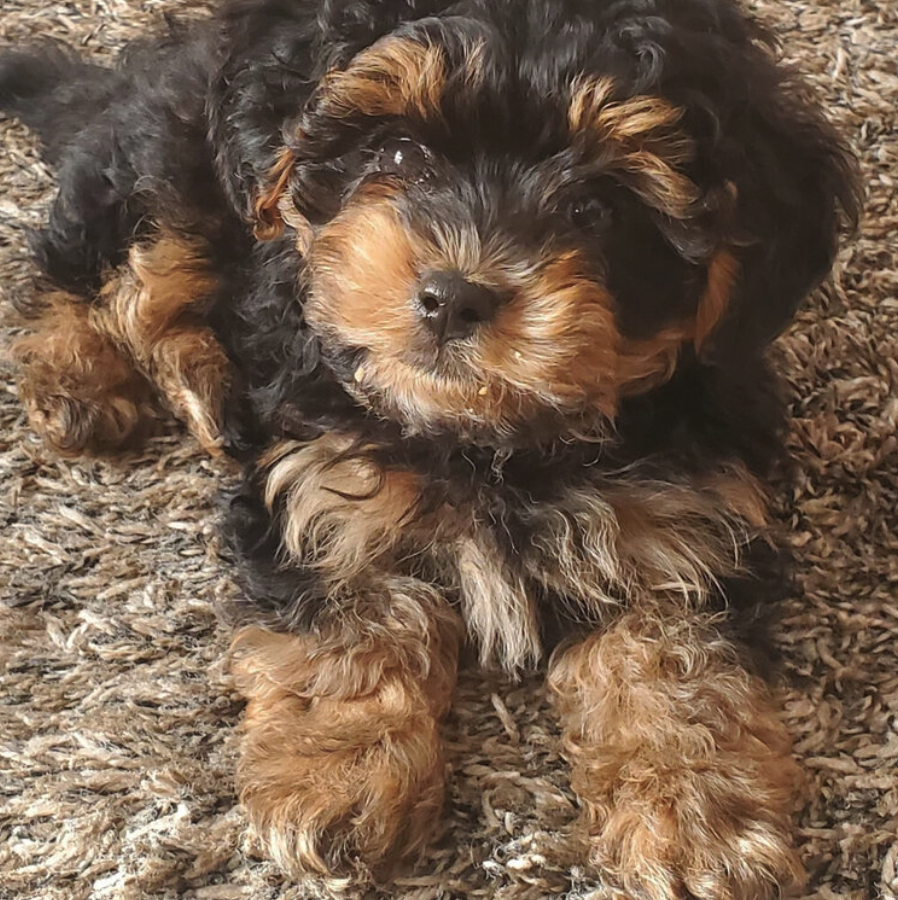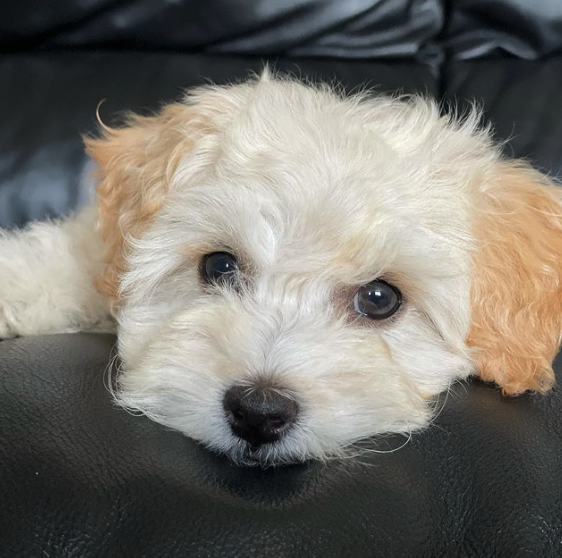
What to Expect from Your 12 Month Old Puppy
At this age your dog will be mostly full grown and gone through all of the stages of a puppy. They will bet at the full height and the maturity level will be mostly that of an adult dog. They should have settled into their personality and habits right now. If properly trained you shouldn’t have many surprises past this point.
Here are some details on the specifics of where your 12 month old Maltipoo will likely be.
How Big - Maltipoos stop growing around 6-8 months. Maltipoos weigh between 3 and 20 lbs and stand between 4 and 14 inches at the shoulder.
Teething - By 12 months, all of their permanent teeth should be in, and they shouldn't be teething anymore.
Ability to hold urine - At this age, they will be able to hold urine for up to 8 hours but should not be expected to any longer. These times should be kept in mind when leaving your dog alone.
Intelligence - At this point, their brain will be almost fully developed if not fully developed, and it will be challenging to teach them new things or correct bad habits, so it is best to get all training done before this time.
Agility - Maltipoos at this age will have 90% of their skill as an adult dog, and they become very accurate and have excellent eye coordination.
Sleep - Your dog will be sleeping around 10-18 hours a day. Puppies usually sleep the same amount of time as adult dogs, but their sleep schedules differ from ours. They sleep a lot more, but they also wake up more often.
Physical appearance and coat - Your dog will look very much like an adult at this age and will have its adult coat. It will need to be brushed regularly and groomed about once a month.
Puberty: Most Maltipoos go through puberty at six months, but it can be anywhere between 4-8 months. They won’t be growing much past this point so everything you buy for them from clothes to bedding should accommodate them for a long time to come.
Can I Get Sick From My Maltipoo?
The very short answer, yes, but it isn’t very common. There are several diseases that you could catch from your dog, but there are also ways to protect yourself from them. The diseases that you could catch are called zoonotic diseases which is simply put, any disease that you could acquire from an animal. They are:
Rabies
Ringworm
Salmonellosis
Leptospirosis
Campylobacter Infection
Giardia
Cryptosporidium infection
Roundworm
Hookworm
Scabies
Harvest Mites
Although it is possible to contract these from your dog, it is still not very likely. However, this risk does increase for people who have a low immune system due to prior illnesses or conditions including:
Persons infected with HIV or suffering from AIDS
Pregnant women
Patients being treated with chemotherapy or radiation therapy
Elderly people
People with chronic diseases or congenital immune system deficiency
People who have received organ/bone marrow transplants
Ways of Prevention
If you feel like you are at a higher risk of catching a disease from your dog, you can use these methods of prevention to keep you and your dog safe.
Contact
Physical contact is one of the most ways diseases are transferred. Make sure you wash your hands after handling your Maltipoo at any point. You might also want to keep your dog extra clean to ensure they didn’t catch anything themselves. Bathing your dog will also help you maintain a better eye on your dog to notice if anything is wrong.
Don’t skip or put off vet checks. Make a scheduled time to take your dog in at spaced-out times. Also, don’t hesitate to take your dog in if you notice anything wrong with your dog.
After hearing all these risks it might make you think twice before getting a dog but this shouldn’t change your mind. There are even some doctors that recommend their patients get a dog to help them through treatments and help stabilize their mind.
There is going to be a little work involved and some people might not be able to handle it but if you can tough it out, it is likely that your life will be much improved with a furry friend by your side. If you are in search of such a furry friend you can check out our available puppies page.
The Best Treats for Training a Maltipoo
Going into training your Maltipoo puppy for the first time is fun but challenging. New dog owners can agree that teaching your pup commands with hand gestures can be tricky. However, Maltipoos are very smart, and they are also food-driven. So with the best treats, your Maltipoo training experience can be a breeze.
The difference between Snacks, Treats, and Chews
While they are very similar, there are a few differences that your little friend might prefer.
Snacks: These are a small portion of food; they are usually dry and crunchy that can help prevent your dog from feeling hungry in between meals.
Treats: Treats are usually small and moist. Their purpose is to give the puppy something delicious and small as a reward that won't fill them up. Treats help encourage the puppy subsequently, making it easier to train them.
Chews: Chewy food is usually going to be hard and take longer to eat. The dog will usually sit or lay down to enjoy its delicious chewy. The main benefit is helping build up their jaw and help their teeth.
What to Look For in Treats
Here is a list of things that you should look for when deciding whether or not you like a brand.
100% all-natural
Contains no cheap fillers that may trigger allergies such as high corn and soy levels.
Soft and moist that won't dry out too quickly (Look for the zipped 'stay fresh' bags)
The flavor should be enticing, immediately sending the message to your dog that it's a reward.
Be small enough that it won't fill up the puppy fast.
Some Great Treat Options
1. WellBites Soft Natural Grain-Free Treats are an excellent example of a great treat. They are perfect little squares that are soft and chewy. They have great meat flavors that dogs love, like chicken & lamb, beef & turkey, chicken & venison, lamb & salmon, and turkey & duck.
Well Bites are made in the USA with 100% natural ingredients with no synthetic additives or preservatives; they contain no corn, soy, or wheat.
2. Zuke's Mini Naturals Dog Treats are another smart option. They are tiny circles that are moist. They also have different flavor options that aren't too filling. So you can choose the one that is perfect for your pup!
These are made in the USA; they're 100% natural with no corn, soy, or wheat.
3. Wellness Soft Puppy Bites are the perfect size for small puppies; they are soft and also have different flavor options.
They use all-natural ingredients with no corn, soy, or artificial colors or flavors.
There are a lot of good options when it comes to training your Maltipoo. With the help of this article, you can make sure you and your puppy both love training time!
Maltipoo Allergies - Causes and Solutions
If your maltipoo is itching uncontrollably, you might want to consider checking to see if they are having an allergic reaction. Allergies are probably the biggest nightmare for most maltipoo owners, but the worst part is when you can’t figure out what the cause is, as a lot of the symptoms are similar for the different causes.
In this article, we’ll be showing you a list of causes for Maltipoo allergies and we hope to help you find the cause of your problem and some quick and long term solutions.
Types of Allergies
Dogs are usually allergic to multiple types of allergen, like pollen, perfumes, metal etc. Crossbreds are more prone to allergies than pure breeds. There is a high chance that your Maltipoo is allergic to some things. Here is a list of the most common types of allergies.
Food Allergies:
This would be anything in the food that they eat. This includes synthetic preservatives, added in by companies to save money. There’s Artificial ingredients, Fillers (used to bulk up food) soy, corn, wheat, some grains, eggs, meat by products, and it’s uncommon, but even some proteins can be a trigger.
Some foods that would be better to feed your Maltipoo would be natural unprocessed protein (lamb, chicken, fish, beef, and turkey). It’s important to make sure you get the unprocessed kind, as many processing methods destroy the protein.
Carbohydrates are one of the most important ingredients in your Maltipoos diet. But you need to be careful as some Maltipoos stomachs have a hard time digesting some of the common carbs, like corn and soy. Look for ones like brown rice and sweet potatoes.
Fats, every maltipoo needs some good fats, they help your puppy keep a nice, shiny, and healthy coat. Fish oils are one of the best ingredients for a healthy coat.
You want to make sure your dog is fed quality dog food that includes all the nutrients they need to stay healthy.
2. Contact Allergies:
Contact allergies are one of the less common allergies but it is always a possibility. This would be something that a dog comes into physical contact with. Plastic bowls is a big one, certain fabrics (like carpet) also can be a cause for allergies
Other triggers would include lawn care chemicals, carpet cleaning solutions, cheap shampoo and other grooming products, toys, and laundry detergent.
3. Inhaled (Environmental/Seasonal) Allergies:
There are many things your Mlatipoo may be breathing in that is causing them to have an allergic reaction.
Common seasonal dog allergens
Pollen
Grass
Weeds
Mold
Fungi
Flea Saliva
Allergy Symptoms to Watch For
Symptoms can be a little confusing because a Maltipoo could have some of them, one of them, ones that change throughout the year, or even all of them. All maltipoos can get allergies, but if their immune system isn’t as strong, they are more likely to have allergies.
Itchy Skin: This is the number one sign that something is causing an allergic reaction from you Maltipoo. Although, it could be shown in different ways, like licking or chewing at the paws, scratching at parts of their body, or rubbing against surfaces.
Skin Reactions: This is another common sign which includes hot spots (specific areas on body are red, irritated, and sometimes moist; hair may also be thinning or balding over these spots), they might have a rash, or excessive dryness.
Coat Issues: This one isn’t as common but it usually occurs when there has been a problem with the skin for a while. This would be things like thinning hair, bald spots, or poor coat textures.
Respiratory Issues: This is also uncommon but it does happen, it would be stuff like coughing, wheezing, sneezing, congestion, runny nose, teary eyes, and exercise intolerance.
Gastrointestinal Distress: This symptom is not a sign of seasonal (inhaled) or contact allergies, but it is a sign of food allergies. This would be things like upset stomach, vomiting, and diarrhea
Other Signs: Teary eyes, red/bloodshot eyes, repeat ear infections.
Diagnosing and Treatment
Even Though it’s always nice to be able to help your Maltipoo at home there are a few reasons why going to the vet is needed.
Diagnosing: Sometimes other issues can mimic allergy symptoms or even it can get confusing deciding which allergies are linked to what as they can have many at a time. So seeing the vet is always a good idea. It can also be hard to pinpoint the exact cause of the allergic reaction.
There are two ways a vet could test to see if your Maltipoo has allergies. The first way is blood testing, it’s often done with the ELISA test, which tests the bloodstream for anti-allergens. This has a few cons though, it is more accurate with airborne allergens rather than food or contact allergies, even then, it can have some false positives because the test was created for humans and not dogs.
The second option is intradermal skin testing. For this one the dog needs to be sedated. A section of the coat is shaved down to expose skin, then tiny pinpricks of common allergies are tested, if there is a reaction, this shows that the puppy is allergic to it.
Treatment - if your Maltipoo is having severe allergic reactions, they may need to take medication to help calm down the itchiness or runny eyes or any other symptoms that may be bothering them.
You can also consider getting allergy shots which would help long term, but you might want to give this some thought before making your decision. Like how you want to give them, or if it is needed. First, make sure your Maltipoo does really have this allergy, then they would get a series of shots. In some cases medication can be given orally, which would be a long term process.
Resolving Maltipoo Allergies
The first thing you want to do is make sure that there are no more triggers that could cause them to have a reaction. Even if you don’t take your puppy to the vet, this is one way to make a big difference.
The number one thing you should check first is their food and snacks, you want to check and see what it is made of and make sure it has no preservatives, dyes, or anything like wheat, grain, soy, or corn.
If you have eliminated these and they are still having a reaction, there is a possibility that they could be allergic to certain proteins. It is very rare, but they can be allergic to chicken or turkey (both are usually extremely well tolerated by most dogs), fish, lamb, beef, rabbit, bison, or any other meat.
But, when you make any changes just remember that it can take a dogs’ body a long time to clear out the food allergies, so you might have to wait about 12 weeks to see changes in the symptoms. You can use sprays and shampoos to help with the symptoms until then.
You also might want to make changes to get rid of the allergens around your house. You’ll want to get rid of any old beds that aren’t being used. Replace pillows that don’t have any protectors. Vacuum your entire house, the floors, couches, pillows. Just vacuuming won’t get rid of all of the dust mites and pollen so sprinkling baking soda on everything and letting it sit for about 15 minutes before vacuuming can help to neutralize them.
Dusting all of the surfaces in your home and getting an air filter will help a lot too. Wash anything that can be with hot water (dog bed cover, clothing, throw rugs, etc.) set your washer temperature to at least 130 F to kill the dust mites.
Once you’ve cleaned your house, keep windows and doors closed, and don’t let anyone walk around with shoes, keep them at the door.
Maltipoos usually aren’t very allergic to a lot of things, but if you do see any of these symptoms, you might want to look into it and find the root cause and get rid of it. If it does ever get severe, the best option is to contact a vet. Allergies can actually be very harmful for your little friend so be sure to watch out for any of these symptoms. But if your puppy is itching or anything else and it doesn’t seem to be from any allergies, it could be other things and you can read more about that in this article: Helping Your Maltipoo with Itching Issues.
Is Your Maltipoo Overweight (How To Avoid It, And What To Do If They Are)
Thorough studies have shown that 56% of dogs in the U.S. are actually overweight or obese. While it is never healthy to let your maltipoo be overweight as it can cause many health problems and complications, especially as they get older, consult your vet to determine whether your maltipoo is in fact overweight, or if your maltipoo is bigger than expected. Your maltipoo being overweight will cause a variety of health complications such as:
Increased risk of cancer
Damage to joints, bones, and ligaments
Increased surgical and anesthetic risk
Decreased life length and quality
What to Avoid
As you may already know, Maltipoos take a lot of time, energy, and attention to keep healthy, but where should you start? Here are the biggest causes for an unhealthy Maltipoo:
Lack of Exercise
Exercise may be one of the biggest factors on your Maltipoo’s health. Just like for a human, exercise is an essential to living a healthy lifestyle for a four-legged furry friend. For a dog, exercise can vary from playing fetch in the backyard to going on a walk through the park. An inactive dog will get overweight much faster than the dog that stays active throughout the day.
Over-Feeding
Overfeeding your Maltipoo can cause your puppy’s stomach to bloat. A Maltipoos bloated tummy puts pressure on other organs and can cause tears in his stomach lining, delay blood flow to the heart, and give them difficulty breathing.
You can avoid feeding your dog too much by putting your little friend on a food schedule. Their food schedule should depend on your dog’s age. Most of the time, the food bag should have a chart on the back that tells you how much to feed your dog, but it can vary depending on the product and product brand.
In general, a young puppy should eat more often than an adult dog because they are growing rapidly. Feeding them about three or four times a day will help them to digest easier. However, it is much more important to not overfeed them. An overweight puppy is more likely to grow up to become an overweight dog.
Signs Your Maltipoo is Overweight
Typically, it is actually really easy to spot some of the symptoms showing whether or not your Maltipoo is overweight, but some are more difficult to spot, especially if you aren’t looking for these signs:
No Palpable Rib Cage
Your maltipoo’s rib cage should not be visible or feel like sharp ridges when you pet him, however, you should be able to feel its ribs with little muscle covering them. You should not have to push through a layer of fat to be able to feel the ribs. If you do have to push through an excess layer of fat to feel your dog’s ribs, your dog is overweight. If you can easily see your Maltipoos rib cage or feel the sharp ridges of your dog’s ribs, your Maltipoo is underweight. It is important to pay attention to these things because this is one of the best signs for telling you whether your dog is malnourished, overweight, or ideal.
No or Hardly Visible Waistline
When you look at your Maltpoo from an above angle, you should see a slight hourglass shape. You should see where their ribs are, and then a waist in front of their hind legs. If your Maltipoo is overweight, you won’t see a waist on your dog as prominently as the ideal weight of Maltipoos. Their body shape will look straight or round.
Remember, if your Maltipoo has a thicker layer of fur, it is really important to make sure you aren’t only watching for the visible signs. A dog that does hav a thicker layer of fur will be much harder to see whether or not he is overweight rather than the dog who has a shorter, thinner layer of fur. It may seem obvious, but not may people actually take the time to use the fee method despite their dog having thick fur, and that sometimes leads to an overweight maltipoo.
So, What If My Maltipoo Is Overweight?
Every dog is different so you should first take him to a professional, or even a local vet, to get a check-up and some advice. If your Maltipoo is overweight, it will take a lot of time, effort, and attention to get your dog back to a healthy state. Despite all that, it is definitely worth it for both you and your dog. Here are some simple ways you can get him back in shape:
Playing Active Games
This can take place almost anywhere. All you really need is space. You can play different games like Fetch, Chase, and any other active games that come to your mind. They are all fine, as long as your dog is being active and moving. For some dogs, you may need to motivate them to get moving with a healthy dog treat, or even some exciting dog toys. Your dog needs to keep moving no matter what.
Taking him on a hike will also help a ton. It will get your dog fresh air and keep him active. However, if your dog is too overweight, he will need to lose a bit before going on this adventure. You should always take your dog on walks, this will help indefinitely. You need to constantly give your dog exercise, as expressed above as it should always be a priority when owning a four-legged friend like yours. It doesn’t matter the breed or the age. Exercise is always one of the keys to a healthy dog.
Feeding Your Dog The Right Food At The Right Time
Feeding your dog the right food is also really important, as well as putting your dog on a food schedule. Feeding your dog too much food is probably going to make the biggest impact on his health. Sure, you should constantly be giving him exercise, but if you are feeding your dog too much anyway, it isn’t going to make the biggest difference.
I cannot stress this enough. If your dog is overweight, you NEED to get your dog on a food schedule. It would also help your dog get faster results if you buy dog food specifically for your dog’s needs. There are many dog food companies that specialize in putting your dog on a diet. Sure, it might be a little more expensive, but it’s definitely worth it considering your dog’s health and life quality is on the line.
Do Maltipoos Colors Change?
The term “Color Changing Dog” isn’t as exciting as it sounds. No, your maltipoo isn’t going to be every color of the rainbow, but it is very likely your Maltipoo’s coat may lighten or darken as he gets older. Maltipoos changing their coat color as they grow up is actually very common, and for the most part, should be expected.
What Causes Color Changing Maltipoos?
There are actually many causes any breed of dog’s coat color may change, but the most common cause is simply aging and nature. As mentioned earlier, a Maltipoo changing color is more common than not, due to genetics.
The Common Changing Colors of Maltipoos
When it comes to your maltipoo changing coat colors, note that some colors are more likely to change than others.
Apricot
If your Maltipoo is an Apricot color, it is very likely for your puppy to change his color when he gets older. With Apricot Maltipoos, the chances your pup’s coat will lighten with age is much higher than the chances it will darken. It is actually very uncommon for an apricot colored maltipoo to transition to a darker shade rather than a lighter one. Most of the time, an apricot Maltipoo will transform into a beautiful Cream-Colored Maltipoo.
Dark Red
Red is also a very likely-to-change color when it comes to Maltipoos as they age. A lot of times they will start out a deep, beautiful red and then grow up and become a much lighter version of that red. It is also very rare for them to darken rather than lighten.
Black And White
A black and white maltipoo could change colors variously. It could range from the darker parts going lighter and the lighter parts going darker or vice versa. The most common way that a black and white maltipoo will change colors is that the black sections of the coat will lighten and get little grey parts in it and the white part will stay exactly as it is.
Seasonal Color Changes
Did you know that a Maltipoo’s coat will often change depending on the season? Well they do. For example, a black Maltipoo will often be completely black in summer, but by the time winter rolls in, that same black dog will have more of a gray coat than the beautiful black coat he had in summer. Or even take the adorable pictures above, for example. The Maltipoo could go a deep brown instead of black during a specific season and be completely black during another season. Note that this doesn’t only occur with black Maltipoos. It can occur with any Maltipoo of any color.
So, When Will My Maltipoo Change Color?
Well, we can’t say for sure because every dog is different. Some dogs don’t change their coat color at all. If your Maltipoo does change colors, it can happen more than just once in your dog’s life. They will most commonly change their coat color about three times. They could be one color at birth, another when the age of adoption, and then a whole new color once they become adults. The biggest change overall will be when your puppy transforms from his puppy fur into his adult fur. If your Maltipoo does not change his coat color during this transformation, your dog might not change colors at all, which is also very common. A Maltipoo changing his coat color is about a 50/50% chance. It is very common both ways.
Can I Stop My Maltipoo From Color Changing?
Well, a Maltipoo changing the color of his coat is a natural process, and you can’t change that, BUT there are companies who specialize in trying to preserve your dog's color with some Color Enhancing Shampoos. We understand. You have the perfect puppy who you love just the way he is and don’t want him to change in any way, and that’s fine too.
Are Maltipoos For You? - Pros and Cons
You’ve probably seen the adorable mix between a Maltese and a Poodle. Maltipoos, they’ve gotten more and more popular in recent years. We’re going to show all of the Maltipoo pros and cons and what you might want to consider while adopting a Maltipoo puppy. They have a lot of good traits, but you also want to make sure Maltipoos are the perfect pup for you.
The Pros of Maltipoos
Maltipoos are the cutest little puppies and they’re so fun to play with.
Maltipoos are Hypoallergenic
One of the many qualities of the Maltipoo is they are considered hypoallergenic. This is a pro for many reasons, it’s a lot less likely to trigger allergies, it’s great for people with asthma, and there's a lot less to clean up from hair fallout. Although Maltipoos are hypoallergenic, there are rare instances a dog can trigger allergies based on their saliva and urine proteins so it’s a good idea to visit and spend a few minutes with a Maltipoo puppy if you’re worried of allergies.
Maltipoos have a Great Temperament
Maltipoos are known to have a mild temperament. They are sweet, affectionate, and gentle. Maltipoos are loyal and enjoy life with a happy demeanor. There are a few differences between males and females.
Males are viewed as more loving, while females are more independent. Males are slightly bigger than females, but only by a few pounds. Females mature faster than males and are usually considered mature by six months.
Maltipoos are the Perfect Small Size
On average, Maltipoos will weigh between 5 to 20 pounds depending on if the poodle parent was toy sized or a moyen. Their small size makes them excellent for smaller homes or even apartments.
Maltipoos come in Many Colors
Another great quality of the Maltipoo is that they come in basically every color imaginable. If you have ever dreamed of having a puppy in a specific color, take a look into the maltipoos and see if it’s the perfect color for you. These color variations can make having a Maltipoo fun and unique.
Maltipoos are Easy to Train
Maltipoos are very intelligent and are easy to train with the right rewards. They are very reward-driven, and this can help speed up the training process. With regular practice, your puppy will learn in no time.
Maltipoos are Great with Kids
If you have children in your home, you’ll have luck with Maltipoo. Maltipoos are gentle and sensitive with little kids, they are understanding and know when they need to be calmer. But as younger children can be a little rougher, they can easily harm a small puppy. Because of this, it is best to keep all children supervised around pets.
They are also sensitive, and they love to be around you all of the time. And when you’re hurt, they can feel it. Their sensitivity also makes them great therapy dogs.
Manageable Energy Levels
Your maltipoo will love to play, they have a lot of energy and need daily exercise. But they don’t require intense workouts of larger breeds. A quick walk around the block or a game of fetch will wear them out. But they might feel like they are too excited sometimes and need help calming down.
Cons of Maltipoos
Like all breeds, Maltipoos have pros and cons.These will probably be the factors you look at when deciding whether a Maltipoo works for you or not. If you can make it through this part, nothing is stopping you from your dream dog.
Grooming
Maltipoos have the fantastic benefit of being hypoallergenic. But this means they are also high maintenance for grooming. One of the best ways to maintain their beautiful hair is by brushing them with a slicker brush every day. You will want to brush them from head to tail, focusing behind the ears and on their stomachs. You will also want to have special brushes in case of mats. If you are able to keep up on this, you will save a lot of time in the long run for grooming.
Stubborn
Like most intelligent breeds, Maltipoos are known to be a little stubborn, especially females. This can make it a little harder to train them but Maltipoos are reward driven so if you have a treat to encourage them, it will be a lot easier.
Common
Yes, the fact that Maltipoos are common is a pro and a con. Because they are so common, it can be hard to find a reputable Maltipoo breeder. There will be a lot of puppy scammers, but there are usually common red flags that you can find out about here, How To Spot a Puppy Scam. Most Maltipoos are likely to come from backyard breeders and puppy mills.
Barking
Like all dogs Maltipoos do bark, but there are a few reasons why your puppy might be barking. This article has different reasons they might be barking and solutions for the different reasons,Do Maltipoos Bark a Lot? The maltipoo barking level is a medium, so not too bad, but they will still bark at some things.
Separation Anxiety
Maltipoos love attention, and if you leave for long periods of time, they may not take it well. Your dog will develop separation anxiety if you separate yourself from them most of the day. But they are so fun to be around so this one shouldn’t be hard.
Known Potential Medical Conditions
As Maltipoos are a mixed breed, it is possible they may get common illnesses that are associated from the breed of either parent. Some of them may include:
Hip and elbow dysplasia
Epilepsy
Diabetes
Eye disease
Tooth and gum disease
And Colitis
While with proper breeding you can reduce these risks. Usually a reputable Maltipoo breeder will have genetic testing done on both parents before the breeding has even taken place. My Doodle Maltipoos test every parent dog in our program and we also offer a 10 year health guarantee for hereditary diseases.
Price
Some may consider the price of the Maltipoo breed to be a con. The price can be as high as $4,000, depending on your area. You may find a lower price on local classifieds but generally you can’t be sure of the health and breed of the parents. The high price of quality breeders can help guarantee you're getting a healthy puppy bred in excellent conditions. And with our puppies, you get a 10 year health guarantee along with your purchase.
Newer Breed
Maltipoos are still considered a new designer breed. It makes them highly sought after, and we still have a lot to learn about them. We can not be sure which traits they will pick up from the Poodle or the Maltese. They are very unpredictable on coat colors and sizes, and there could be a medical condition that we don’t know about yet. But for the most part, they are pretty consistently healthy and happy dogs.
Food
Another con is that Maltipoos eat a lot. You will find that they always seem hungry if not fed a proper diet. We have done some research and found out the best way to feed your maltipoo, Properly feeding your Maltipoo. They can also quickly become obese if the owner isn’t careful.
Now that you’ve seen all of the pros and cons, you can decide whether a Maltipoo is for you. We think they are the best dogs out there. They are great family dogs and also great apartment dogs if you live alone in a small area. If you are interested in one of our puppies you can check out our available Maltipoo puppies.
How Long Can Maltipoos Be Left Alone?
We know, Maltipoo Puppies are so cute, who would ever want to leave them alone? But the harsh reality is there are times that require us to be away for longer than we’d like. In this article, we will offer some guidelines for keeping your Maltipoo safe and entertained while being home alone.
There are many factors to consider when thinking about how long to leave your puppy home. Their age, size, temperament, and how much training and practice they have in house manners. One of the most important things you never want to forget when you get a puppy, and that is teaching your puppy how to enjoy being alone.
Also, puppies need to use the bathroom a lot more often than adult dogs.
How long is Your Maltipoo Required to “Hold It”?
One important factor to consider is how long between potty breaks your puppy or adult dog can be expected to hold it. The main guideline to use is age. As a puppy matures, its bladder will grow much stronger. From only being able to hold it for 1 hour or so, to holding it for 8+ hours. Here are a few age guidelines you can use to consider the frequency your dog should go out.
8 to 10 weeks:
When you just adopt a puppy is when you should stay with them the most, just so they can become more familiar with you and their new environment. They also have really small bladders, so they are more likely to have an accident if you leave them for too long.
So when they are this young, they should only be left alone for about an hour in a puppy safe place like a kennel or a playpen with toys and comfortable bedding
10 to 12 weeks:
Once they are a little bit older, they start to gain some independence, but they still can’t be left alone for a full day because they are still curious. Instead, puppies should be alone for no longer than two hours, but you should still be aware that accidents are still very likely to happen.
So when you do leave, use baby gates to keep them in a hard floor area and this will make cleanup a lot easier.
3 to 6 Months:
Once your puppy reaches about 3 to 6 months, you can consider the one-hour-per-month rule. 3-month-old puppies can be alone for three hours, and 4-month old puppies can be alone for four hours.
Bathroom issues will be less common, but not completely gone. Maltipoo’s bladder also used the same month rule, so however old they are is how many hours they can hold it, Maltipoo Training by Age. Also, remember that negative reinforcements don’t generally work, especially when it’s hours later when you return.
Now, you can also extend the area that they are left in, but before you do, it’s best to make sure that it is safe and do a test run that is shorter and ease your puppy into the longer times and make sure they can handle it.
7+ Months:
By now, they can hold their bladder long enough, and you can leave them alone if they show signs that they are ready.
However, there is another issue that you need to be aware of, before they are 1 year old, puppies are likely to chew, bite, and ruin things if they begin to feel scared or upset. So if you ever come home to some furniture chewed up and ruined, your puppy might be telling you that they're not ready to stay alone for that long yet.
How Long Can You Leave Your Maltipoo In a Crate?
Crate training is very important, the first thing to remember is to keep it positive, like give them treats or other things so, to them, it feels like a reward. It’s better to start slow and limit how long they stay in there. When you are first training them, try 10-15 minutes and see if they're ready for more time or if they need more help. If they are having a harder time in the crate, try leaving the crate open.
Maximum time in crate recommended by age:
8-10 weeks: 30-60 minutes
11-14 weeks:1-3 hours
15-16 weeks: 3-4 hours
12+ weeks: 4-5 hours (Although, it is not healthy to do this very often)
Also, having a crate trained puppy has so many benefits, it creates a place where the puppy can feel safe if they ever feel scared, it also makes housebreaking a lot easier. Another big benefit is you can transport the puppy safely and they’ll enjoy it. You do want to make sure you’re not leaving them in there for too long otherwise they won’t like it and will have a harder time staying in there in the future.
How Can You Train Your Maltipoo To Manage Alone Time?
First of all, your dog needs to learn to let you leave and come back. Maltipoos whining is one problem owners face when leaving the house. Even though your dog showing you that he misses you by running up to you, it’s not good for them to have this type of behavior.
Train your dog to let you leave.
First, walk to the door with your shoes as if you were leaving. Walkout and come back, if your dog jumps up and runs after you, command them to go back and sit in a faraway spot. Repeat this procedure and when they stay, reward them with a puppy treat.
The next thing is to train them to stay calm when you come back home. Usually, they’ll get excited and bark happily, but you should ignore this behavior completely until they quiet down.
Then, command them to go sit in a spot and when they listen, give them a treat and all of the attention and love they deserve, because you’ll probably miss them too! Training isn’t about withholding attention, it’s about giving it to them at the right time.
How Can You Make Being Alone Easier For Your Maltipoo?
If your dog isn’t super bored while you are gone, they tend to behave better while you are gone or when you get back. There are many ways to make sure your pup has fun while you’re gone too.
For starters, tiring out your little friend before you leave is a great idea. Like taking them for a walk, or even playing a fun game in the yard that lets them run around. Then, they are more likely to take a nap while you are gone.
Get some toys for your puppy that will keep them occupied, like some puppy puzzles, which most of the time have a spot where you can put a treat for when they solve the puzzle. You can get a lot of different kinds here.




